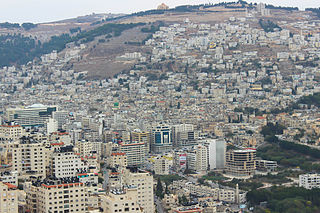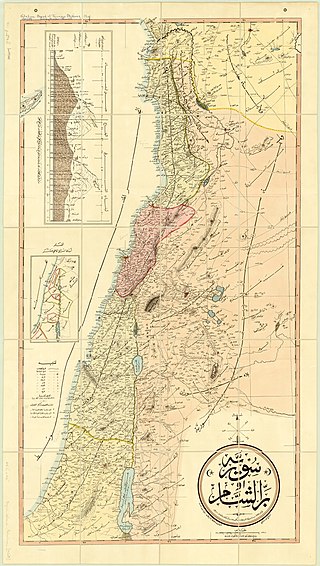
Nablus is a Palestinian city in the West Bank, located approximately 49 kilometres (30 mi) north of Jerusalem, with a population of 156,906. Located between Mount Ebal and Mount Gerizim, it is the capital of the Nablus Governorate and a commercial and cultural centre of the State of Palestine, home to An-Najah National University, one of the largest Palestinian institutions of higher learning, and the Palestine Stock Exchange. Nablus is under the administration of the Palestinian National Authority (PNA).

The Battle of Jerusalem occurred during the British Empire's "Jerusalem Operations" against the Ottoman Empire, in World War I, when fighting for the city developed from 17 November, continuing after the surrender until 30 December 1917, to secure the final objective of the Southern Palestine Offensive during the Sinai and Palestine Campaign of World War I. Before Jerusalem could be secured, two battles were recognised by the British as being fought in the Judean Hills to the north and east of the Hebron–Junction Station line. These were the Battle of Nebi Samwill from 17 to 24 November and the Defence of Jerusalem from 26 to 30 December 1917. They also recognised within these Jerusalem Operations, the successful second attempt on 21 and 22 December 1917 to advance across the Nahr el Auja, as the Battle of Jaffa, although Jaffa had been occupied as a consequence of the Battle of Mughar Ridge on 16 November.

Ahmed Pasha al-Jazzar was the Acre-based Ottoman governor of Sidon Eyalet from 1776 until his death in 1804 and the simultaneous governor of Damascus Eyalet in 1785–1786, 1790–1795, 1798–1799, and 1803–1804. Having left his native Bosnia as a youth, he began a military career in Egypt in the service of mamluk officials, eventually becoming a chief enforcer and assassin for Ali Bey al-Kabir, Egypt's practical ruler. He gained the epithet of al-Jazzar for his deadly ambush on a group of Bedouin tribesmen in retaliation for the death of his first master in a Bedouin raid. Al-Jazzar fell out with Ali Bey in 1768 after refusing to take part in the assassination of another of his former masters. He ultimately fled to Syria, where he was tasked by the Ottomans with defending Beirut from a joint assault by the Russian Navy and Zahir al-Umar, the Acre-based ruler of northern Palestine. He eventually surrendered and entered Zahir's service before defecting from him and fleeing with stolen tax money.

Sanur is a Palestinian village located 26 kilometres (16 mi) southwest of Jenin, in the Jenin Governorate of the State of Palestine. According to the Palestinian Central Bureau of Statistics, Sanur had a population of 4,067 in 2007 and 5,036 in 2017. During the late Ottoman era, Sanur served as a fortified village of the Jarrar family and played a key role in limiting the centralized power of the Ottoman sultanate, the Ottoman governors of Damascus and Acre and the Ottoman-aligned Tuqan family of Nablus from exerting direct authority over the rural highlands of Jabal Nablus.
Following are timelines of the history of Ottoman Syria, taken as the parts of Ottoman Syria provinces under Ottoman rule.
The Peasants' Revolt was a rebellion against Egyptian conscription and taxation policies in Palestine. While rebel ranks consisted mostly of the local peasantry, urban notables and Bedouin tribes also formed an integral part of the revolt. This was a collective reaction to Egypt's gradual elimination of the unofficial rights and privileges previously enjoyed by the various classes of society in the Levant under Ottoman rule.

The 1834 looting of Safed was a month-long attack on the Jewish community of Safed in the Sidon Eyalet of the Ottoman Empire during the Peasants' revolt in Palestine. It began on Sunday, June 15, the day after the Jewish holiday of Shavuot, and lasted for 33 days. It has been described as a spontaneous attack on a defenseless population during the armed uprising against the rule of Ibrahim Pasha of Egypt, the Ottoman governor. The event took place during a power vacuum while Ibrahim Pasha was fighting to quell the wider revolt in Jerusalem.
The 1838 Druze attack on Safed began on July 5, 1838, during the Druze revolt against the rule of Ibrahim Pasha of Egypt. Tensions had mounted as the Druze captured an Egyptian garrison outside of Safed. The local Safed militia of several hundred was heavily outnumbered by the Druze, and the city was gripped in despair as the militia eventually abandoned the city and the Druze rebels entered the city on July 5. The Druze rebels and a Muslim mob descended on the Jewish quarter of Safed and, in scenes reminiscent of the Safed plunder four years earlier, spent three days attacking Jews, plundering their homes and desecrating their synagogues. Besides religious and sectarian tensions, the Jewish community in Safed was seen as being favorable toward Ibrahim Pasha and the Egyptian Eyalet. Some Jews ended up leaving the town, moving south to Jerusalem and Acre. Among them was Yisrael Bak, whose printing press had been destroyed a second time.
The timeline of the Palestine region is a timeline of major events in the history of Palestine. For more details on the history of Palestine see History of Palestine. In cases where the year or month is uncertain, it is marked with a slash, for example 636/7 and January/February.
The Battle of Hebron occurred in early August 1834, when the forces of Ibrahim Pasha of Egypt launched an assault against Hebron to crush the last pocket of significant resistance in Palestine during the Peasants' revolt in Palestine. After heavy street battles, the Egyptian army defeated the rebels of Hebron, and afterward subjected its inhabitants to violence following the fall of the city. About 500 civilians and rebels were killed, while the Egyptian Army experienced 260 casualties.

The Mutasarrifate of Jerusalem, also known as the Sanjak of Jerusalem, was a district in Ottoman Syria with special administrative status established in 1872. The district encompassed Jerusalem as well as Hebron, Jaffa, Gaza and Beersheba. During the late Ottoman period, the Mutasarrifate of Jerusalem was commonly referred to as Palestine; a very late Ottoman document describes Palestine as including the Sanjak of Nablus and Sanjak of Akka (Acre) as well, more in line with European usage. It was the 7th most heavily populated region of the Ottoman Empire's 36 provinces.
Throne villages were villages in the central mountain areas of Palestine that served as seats of political and military power for the local leaders (sheikhs) of rural subdistricts primarily during the latter half of Ottoman rule.
Qasim Pasha al-Ahmad was the chief of the Jamma'in subdistrict of Jabal Nablus during the Ottoman and Egyptian periods in Palestine in the mid-19th century. He also served as the mutassalim of Jerusalem between 1832 and 1833. Qasim headed the Qasim clan, a prominent rural family of Jabal Nablus. He led the peasants of Palestine in their revolt against the Egyptian rule of Ibrahim Pasha in 1834. Following the revolt's suppression, he was captured and executed by the authorities.
Sulayman Pasha al-Adil was the Ottoman governor of Sidon Eyalet between 1805 and 1819, ruling from his Acre headquarters. He also simultaneously served as governor of Damascus Eyalet between 1810 and 1812. He was a mamluk of his predecessor, Jazzar Pasha. His rule was associated with decentralization, a reduction of Acre's military, and limits to his predecessors' cotton monopoly. Moreover, he oversaw a policy of non-interference with his deputy governors, such as Muhammad Abu-Nabbut and Mustafa Agha Barbar, and diplomacy with the autonomous sheikhs of the various Levantine regions where he held authority, including Emir Bashir Shihab II and Musa Bey Tuqan. He exercised control over his domain largely through depending on the loyalty of his deputies, who also had been mamluks of Jazzar. In effect, Sulayman Pasha presided over the world's last functioning mamluk system.
Abdullah Pasha ibn Ali was the Ottoman governor (wali) of Sidon Eyalet between May 1820 and May 1832, with a nine-month interruption in 1822–23. Like his predecessors Jazzar Pasha and Sulayman Pasha, Abdullah Pasha ruled from the port city of Acre. During his reign, all of Palestine and the Syrian coastline came under his jurisdiction. Among his major military victories was his survival of an imperial-backed siege of Acre in 1822 instigated by the Farhi family in retaliation for Abdullah's execution of his mentor Haim Farhi, the suppression of revolts in Mount Lebanon and Jerusalem in 1824 and 1826, respectively, and the 1831 capture of the Sanur fortress.
Husayn Abd al-Hadi was a sheikh of the Jabal Nablus region, head of the Abd al-Hadi clan of Arraba and a deputy of Ibrahim Pasha in Palestine. During Ibrahim Pasha's rule, he also served as the governor of Sidon Eyalet.
The Naqib al-Ashraf revolt was a popular uprising in Jerusalem against the Ottoman authorities between May 1703 and October 1705. It was led by the city's naqib al-ashraf, Muhammad ibn Mustafa al-Husayni al-Wafa'i, and the rebels consisted of townspeople, peasants from nearby villages, local Bedouins, and religious notables (ulama). For over two years the rebels engaged in virtual self-rule in the city. However, divisions emerged within rebel ranks, and following an Ottoman siege, the rebel camp led by al-Husayni fled the city and were later captured and executed.

Siege of Al-Karak was a 17-day siege imposed by Ibrahim Pasha of Egypt on the Transjordanian town of Al-Karak in 1834. The Pasha laid the siege on the town in pursuit of Qasim al-Ahmad, the leader of the Peasants' revolt in Palestine, who had fled from Nablus to take shelter in Al-Karak.

The Syrian peasant revolt of 1834–1835 was an armed uprising of Levantine peasant classes against the rule of Ibrahim Pasha of Egypt. The revolt took place in areas of Ottoman Syria, at the time, ruled by the semi-independent ruler of Egypt, who conquered the region from loyal Ottoman forces in 1831.
The Alawite revolt, also known as the Nusayri rebellion, was one of the arenas of the Syrian Peasant Revolt (1834–1835). Between 1834 and 1835, the Alawites (Nusayris) rose up against Egyptian rule of the region, while pro-Egyptian governor of Homs Salim Beg and the forces of Emir Bashir Shihab II of the Mount Lebanon Emirate, commanded by Khalil and his relatives, participated in the suppression of revolts in Akkar, Safita, the Krak des Chevaliers and an Alawite revolt in the mountainous region of Latakia.








